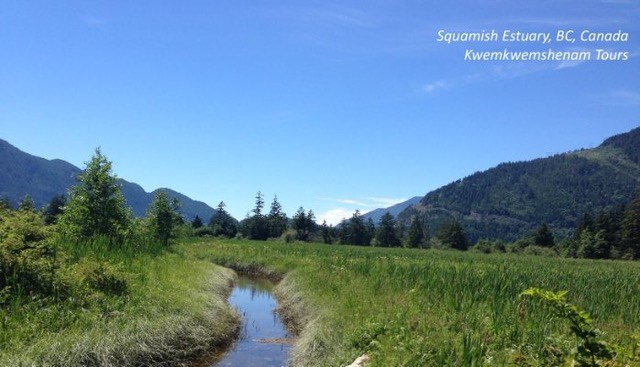Grab your walking shoes and join us for a cultural tour of the Squamish Estuary, one of the largest estuaries in southwestern BC and habitat for hundreds of species of birds, fish and other marine life. This easy walk is another event in the Reconciliation Initiative, Knowing Our Place. We will stroll through the former site of a Squamish Nation village, Skwelwil’em, guided by a Squamish Nation storyteller singing the traditional songs and telling the legends that come from the land and the people.
Kwemkwemshenam Cultural Tours is the dream-come-true of Chrystal Nahanee, whose traditional name is Sunsa weesumqa. Chrystal chose the name Kwemkwemshenam, which means “Stomping Feet.” as a reminder to “walk in nature with light feet, to make little footprints and be respectful of the diverse, fragile ecosystem.” She adds, “When it’s time to protect our estuaries and cultural sites, we invite people of all cultures and nations to stomp together to protect its natural beauty.”
The estuary is a fertile environment. It has made life possible in the Squamish area for thousands of years. When salt water from Howe Sound and fresh water from the Squamish River come together in the estuary, they create an idyllic environment for the enhancement of life, both human and other-than-human. Estuaries act as nurseries for small creatures, and are one of the most productive natural habitats in the world, essential for the survival of plants, animals, birds and amphibians, fish and many other aquatic species. Estuaries in BC cover less than three percent of the coast while providing habitat that is used by eighty percent of the species found on the coast.
A century of uncontrolled logging, a chemical plant and a pulp mill devastated the Squamish Estuary’s lush environment, polluting it with dioxins, furans, mercury and other toxins. For nearly thirty years, the central estuary at the mouth of the Squamish River lay buried under thousands of years of river dredge material. It looked more like a moonscape than an estuary.
In the past three decades, the Squamish Nation, governments, business and citizens have worked to recover the health of the estuary. On a tour of the estuary last year with Edith Tobe, Executive Director of the Squamish River Watershed Society, I observed the miraculous renewal that is taking place. Since 1993, the society has worked to restore the estuary, replanting eelgrass and other native plants, making it more hospitable to salmon and humans. The eelgrass now shelters herring and many other fishy things that provide food for salmon, birds and even elk.
I am grateful to Bowen Island Arts Council for their help in putting this special event together, and to our sponsors: the Bowen Island Library, Knick Knack Nook, Literacy Task Group, First Credit Union, and to Peter King for providing the bus.
Follow your stomping feet and arrive in the Cove to board the bus at 9:00 am on Sunday, September 17. We will be on the 9:35 ferry and Peter King will take us to Squamish for the tour, stop for lunch, and return in time for the 3:45 ferry. Cost is $30 for the tour and $10 for the bus.
Please register early to make sure you get a seat. To register: email Jacqueline at [email protected]. For more information email me at [email protected] or Jacqueline at [email protected]



